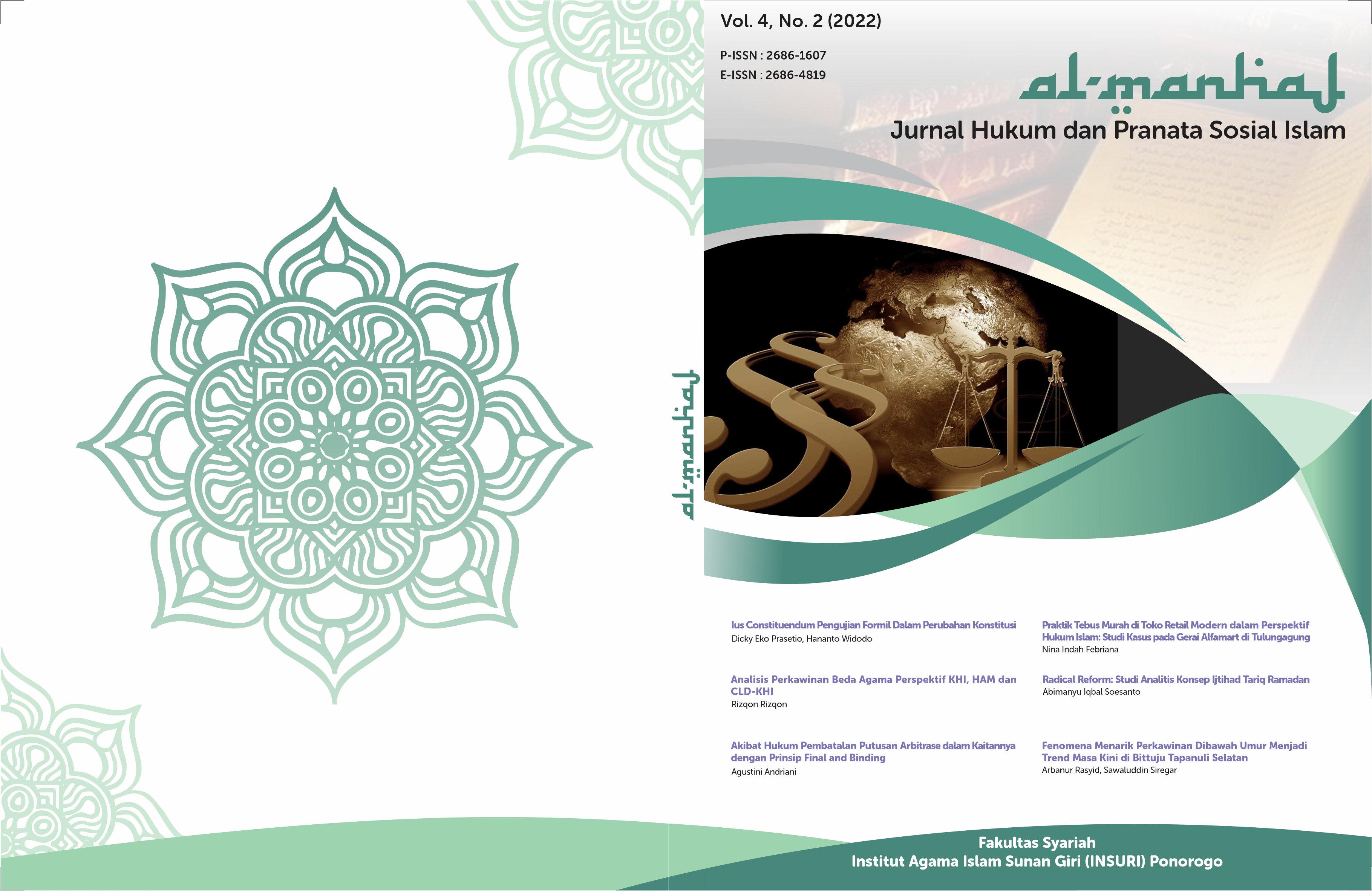Can An Anti-Dumping Policy Be Substituted For Predatory Pricing?
DOI:
https://doi.org/10.37680/almanhaj.v4i2.1683Keywords:
Anti-dumping; Predatory pricing; Competition LawAbstract
One of the most contentious issues in international commerce is anti-dumping (AD). And among the controversies of this AD rule, there is also what is considered in “conflict” with business competition law, both in terms of the purpose of the regulations and from the rules themselves. One of them is related to predatory pricing. Therefore, this study aims to conduct further analysis regarding the possibility of predatory pricing rules in substituting anti-dumping regulations in Indonesia. Based on these aims, this study employs a normative method with a statutory and conceptual approach. This study then reveals that dumping can be classified as a predatory pricing practice in terms of indications and impacts. However, the legal consequences and consequences of the two are different. So it would be impossible if anti-dumping arrangements were substituted with predatory pricing. Nevertheless, this research still supports that anti-dumping regulations are included in the regulation or law prohibiting unfair business competition and monopolistic practices because the practice of dumping itself is an unfair business competition practice.
References
Avsar, V. (2018). R&D intensity, financing cost and antidumping. Applied Economics, 50(39), 4275–4285. https://doi.org/10.1080/00036846.2018.1441524
Azzopardi, A. (2017). No abuse is an island: the case of margin squeeze. European Competition Journal, 13(2–3), 228–248. https://doi.org/10.1080/17441056.2017.1379730
Bagchi, S., Bhattacharyya, S., & Narayanan, K. (2014). Does Anti-dumping Enforcement Generate Threat?: Foreign Trade Review, 49(1), 31–44. https://doi.org/10.1177/0015732513515988
Bagchi, S., Bhattacharyya, S., & Narayanan, K. (2015). Anti-dumping Initiations in Indian Manufacturing Industries: South Asia Economic Journal, 16(2), 278–294. https://doi.org/10.1177/1391561415598462
BI, Y. (2013). Is Dumping Still Harmful? New Thinking on Antidumping in the Global Free Trade. Journal of East Asia and International Law, 6(1), 29–51.
BI, Y., & VAN UYTSEL, S. (2015). Could Predatory Pricing Rules Substitute for Antidumping Laws in the Proposed China–Japan–Korea Free Trade Agreement? Social Science Japan Journal, 18(2), 163–192. https://doi.org/10.1093/SSJJ/JYV010
Blonigen, B. A., & Prusa, T. J. (2016). Dumping and Antidumping Duties. Handbook of Commercial Policy, 1, 107–159. https://doi.org/10.1016/BS.HESCOP.2016.04.008
Botta, M. (2020). Sanctioning unfair pricing under Art. 102(a) TFEU: yes, we can! European Competition Journal, 17(1), 156–187. https://doi.org/10.1080/17441056.2020.1860566
Cai, J. (2020). The sharing economy and China’s antimonopoly law: from the Didi case to regulatory challenges*. Asia Pacific Law Review, 28(1), 159–178. https://doi.org/10.1080/10192557.2020.1786250
Chang, R. Y., Hwang, H., & Peng, C. H. (2019). Antidumping protection and welfare in a differentiated duopoly. The Japanese Economic Review, 71(3), 421–446. https://doi.org/10.1007/S42973-019-00024-9
Cheng, H. F. G. (2020). An economic perspective on the inherent plausibility and frequency of predatory pricing: the case for more aggressive regulation. European Competition Journal, 16(2–3), 343–367. https://doi.org/10.1080/17441056.2020.1770478
Debaere, P. (2017). Fishy Issues: The U.S. Shrimp Antidumping Case. Darden Business Publishing Cases, 1(1), 1–15. https://doi.org/10.1108/CASE.DARDEN.2016.000123
Dung, T. V. (2006). Anti-dumping Policy from a competition perspective: An artificial shield for national champions in open market What to do about it? Asia Competition Law Bulletin, 2, 57–78.
Egerod, B. C. K., & Justesen, M. K. (2021). Asset Specificity, Corporate Protection and Trade Policy: Firm-Level Evidence from Antidumping Petitions in Nineteen Jurisdictions. British Journal of Political Science, 1–10. https://doi.org/10.1017/S0007123420000939
Feinberg, R. M. (2013). Antidumping and Industrial Organization. Review of Industrial Organization 2013 42:4, 42(4), 365–368. https://doi.org/10.1007/S11151-013-9384-X
Gani, W. (2020). Excessive prices: a new analytical approach. European Competition Journal, 17(1), 23–46. https://doi.org/10.1080/17441056.2020.1839227
Hutchinson, C. S., & Treščáková, D. (2021). The challenges of personalized pricing to competition and personal data protection law. European Competition Journal, 1–24. https://doi.org/10.1080/17441056.2021.1936400
Leslie, C. R. (2013). Predatory Pricing and Recoupment. Columbia Law Review, 113(7).
Macrory, P. F. J. (2005). The Anti-Dumping Agreement. The World Trade Organization: Legal, Economic and Political Analysis, 485–529. https://doi.org/10.1007/0-387-22688-5_11
Mankiw, N. G., & Swagel, P. L. (2005). Antidumping: The third rail of trade policy. Foreign Affairs, 84(4), 107–119. https://doi.org/10.2307/20034424
Mateus, A. M. (2011). Predatory Pricing: A Proposed Structured Rule of Reason. European Competition Journal, 7(2), 243–267. https://doi.org/10.5235/174410511797248261
Meisel, J. B. (2015). The Law and Economics of Margin Squeezes in the US Versus the EU. European Competition Journal, 8(2), 383–402. https://doi.org/10.5235/ECJ.8.2.383
Mukunoki, H. (2021). Trade liberalization and incentives to implement antidumping protection. International Review of Economics & Finance, 72, 422–437. https://doi.org/10.1016/J.IREF.2020.11.015
Omphemetse S. Sibanda, S. (2020). Procedural Requirements of the South African Anti-Dumping Law and Practice Prior to Imposition of Anti-Dumping Duties: Are They Really WTO-inconsistent?: Foreign Trade Review, 55(2), 216–238. https://doi.org/10.1177/0015732519894150
Ranjan, P. (2004). International Predation and Anti-Dumping. Economic and Political Weekly, 39(45), 4880–4883.
Sandkamp, A., & Yalcin, E. (2021). Different antidumping legislations within the WTO: What can we learn from China’s varying market economy status? Review of International Economics, 29(5), 1121–1147. https://doi.org/10.1111/ROIE.12538
Schmidt, I., & Richard, S. (1992). Conflicts between antidumping and antitrust law in the EC. Intereconomics 1992 27:5, 27(5), 223–229. https://doi.org/10.1007/BF02928050
Schön, W. (2015). Corporate Disclosure in a Competitive Environment—The Quest for a European Framework on Mandatory Disclosure. Journal of Corporate Law Studies, 6(2), 259–298. https://doi.org/10.1080/14735970.2006.11419953
Song, J. heon, & Lee, K. joo. (2013). Bureaucratic politics, policy learning, and changes of antidumping policy and rules in Japan. Journal of International Trade Law and Policy, 12(1), 4–22. https://doi.org/10.1108/14770021311312476/FULL/XML
Subekti. (1992). Hukum Perjanjian. jakarta: Intermasa.
Tabakis, C., & Zanardi, M. (2017). Antidumping Echoing. Economic Inquiry, 55(2), 655–681. https://doi.org/10.1111/ECIN.12369
Taylor, J. E., Moldoveanu, M., & Taylor, J. L. (2013). Product Characteristics and the Effectiveness of Dow’s Countermeasure for Predatory Pricing. International Journal of the Economics of Business, 20(1), 1–14. https://doi.org/10.1080/13571516.2012.750043
Tutik, T. T. (2008). Hukum perdata dalam sistem hukum nasional. jakarta: Kencana.
Usanti, T., & Roro, F. (2017). Legal Protection of the Contracting Parties in The Peer To Peer Lending Based on Financial Technology (P2p Lending Fintech) in Indonesia. Proceedings of the International Conference on Law, Governance and Globalization, 282–295. Atlantis Press. https://doi.org/10.2991/iclgg-17.2018.37
Vandenbussche, H., & Viegelahn, C. (2013). The Trade Impact of Indian Antidumping Measures against China: Evidence from Monthly Data: Foreign Trade Review, 48(1), 1–21. https://doi.org/10.1177/001573251204800101
Xiang, H., Zongxian, F., & Xuyuan, L. (2011). Research on early warning system for antidumping petition: Based on panel data logit model. Journal of Chinese Economic and Foreign Trade Studies, 4(3), 158–172. https://doi.org/10.1108/17544401111178203/FULL/XML
Yoon, Y. (1994). The Korean Chip Dumping Controversy: Are They Accused of Violating an Unjust Law. North Carolina Journal of International Law, 19(2), 247–266.
Zaid, Z. (2022). The Unicorn Is a Myth No More: A Ratio Decidendi Analysis on First Official Predatory Pricing Case in Indonesia. Jurnal Penegakan Hukum Dan Keadilan, 3(1), 48–59. https://doi.org/10.18196/JPHK.V3I1.13099
Zaid, Z., & Aufa, M. F. (2022). Peran Undang-Undang Persaingan Usaha dalam Meningkatkan Pertumbuhan Ekonomi. Jurnal Pamator : Jurnal Ilmiah Universitas Trunojoyo, 15(1), 89–99. https://doi.org/10.21107/pamator.v15i1.14282
Zaid, Z., Dawaki, F. A., & Ololade, S. K. (2021). Should the State Control Tariffs? Journal of Governance and Public Policy, 8(1), 22–36. https://doi.org/10.18196/JGPP.811340
Downloads
Published
How to Cite
Issue
Section
License
Copyright:
- Author retains the copyright and grants the journal the right of first publication of the work simultaneously licensed under a Creative Commons Attribution 4.0 International License that allows others to share the work with an acknowledgment of the work's authorship and initial publication in this journal.
- Author is able to enter into separate, additional contractual arrangements for the non-exclusive distribution of the journal's published version of the work (e.g., post it to an institutional repository or publish it in a book) with the acknowledgment of its initial publication in this journal.
- Author is permitted and encouraged to post his/her work online (e.g., in institutional repositories or on their website) prior to and during the submission process, as it can lead to productive exchanges, as well as earlier and greater citation of the published work (See The Effect of Open Access).
License:
-
Attribution — You must give appropriate credit, provide a link to the license, and indicate if changes were made. You may do so in any reasonable manner, but not in any way that suggests the licensor endorses you or your use.
-
No additional restrictions — You may not apply legal terms or technological measures that legally restrict others from doing anything the license permits.
You are free to:
- Share — copy and redistribute the material in any medium or format
- Adapt — remix, transform, and build upon the material for any purpose, even commercially.

This work is licensed under a Creative Commons Attribution 4.0 International License.














